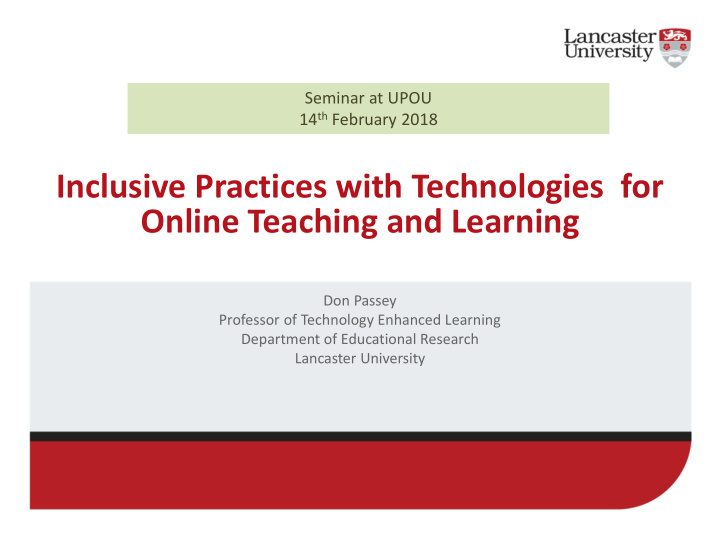



Seminar at UPOU 14 th February 2018 Inclusive Practices with Technologies for Online Teaching and Learning Don Passey Professor of Technology Enhanced Learning Department of Educational Research Lancaster University
Summary • Background • Discussing exclusion • Defining inclusion • Identifying technologies to support inclusive practices • Considering inclusive practices • Conclusions • Questions
Background • My interest is in learning • Both how people learn, across the lifespan, but also why people find it difficult to learn • My focus is then on technologies, how they are involved, to support and enhance learning • I’ve worked online for many years • I’ve been the director of an online programme • I reviewed reasons for exclusion in 2010 • Completed a wide literature review of technologies supporting inclusive practices in 2013 • Reviewed inclusive practices in online learning in 2015
Discussing exclusion • There are many categories of exclusion: – Physical (e.g. motor, visual, hearing) – Cognitive (e.g. dyslexia, dyscalculia, autism) – Social (e.g. ethnic and cultural approaches, language, low income, communication barriers) – Emotional and behavioural (disengagement, aggression, elective mutism, emotionally abused, mental health issues) – Geographic or locality-based (remote, rural, hospitalised, in prison) Source: Passey, D. (2010).
A question • As an online educator, which of these do you need to know about, and why? – Physical (e.g. motor, visual, hearing) – Cognitive (e.g. dyslexia, dyscalculia, autism) – Social (e.g. ethnic and cultural approaches, language, low income, communication barriers) – Emotional and behavioural (disengagement, aggression, elective mutism, emotionally abused, mental health issues) – Geographic or locality-based (remote, rural, hospitalised, in prison)
Defining inclusion • There are many categories of inclusion: – Physical (e.g. accommodating motor, visual, hearing) – Cognitive (e.g. accommodating dyslexia, dyscalculia, autism) – Social (e.g. accommodating ethnic and cultural approaches, language, low income, communication barriers) – Emotional and behavioural (accommodating disengagement, aggression, elective mutism, emotionally abused, mental health issues) – Geographic and locality-based (accommodating remote, rural, hospitalised, in prison) Source: Passey, D. (2017).
Identifying technologies to support inclusive practices Inclusive features to accommodate Technologies to support Physical (e.g. accommodating motor, visual, hearing) Cognitive (e.g. accommodating dyslexia, dyscalculia, autism) Social (e.g. accommodating ethnic and cultural approaches, language, low income, communication barriers) Emotional and behavioural (accommodating disengagement, aggression, elective mutism, emotionally abused, mental health issues) Example image Geographic (accommodating remote, rural, hospitalised, in prison)
Addressing exclusion • Researchers still feel that technological platforms are not necessarily addressing exclusion: – Some online learning practices erect barriers to individuals with disabilities—uncaptioned videos are not accessible to students who are deaf, content presented only within graphic images is not accessible to individuals who are blind, unorganized content cluttered on a page creates barriers to some students with learning disabilities and attention deficits, web pages that require the use of a mouse are inaccessible to those who cannot operate a mouse. (Burgstahler, 2015: 69)
Examples of inclusive practices • The findings suggest that not only can computer-mediated communications afford [Asperger’s Syndrome] AS-diagnosed learners opportunities to participate meaningfully in group- work, but also that the learner demonstrated higher levels of collective-inclusive versus individual-exclusive phraseology than neurotypical peers, thereby challenging assumptions around participation in collaborative learning activities and assimilation of peer-feedback. (McDowell, 2015: 7) • This study revealed several benefits and challenges that emerge when people with [Intellectual Disabilities] ID engage with mobile technologies as co-producers of videos about the functionings and capabilities that underlie their community and residential integration process. (Davidson, 2015: 26)
Considering inclusive practices From a theoretical perspective, a range of key factors for online • tutors to consider are (in potential order of importance according to findings in the analysis in this paper): – Spatial and physical barriers in the user environment; – Implications of tutor or learning focus for user engagement with activities; – Social focus (managing group work involving learners and tutors and appropriate interactions); – Emotional focus (and tutors and learners recognising that specific elements of concern such as anonymity may not be accepted in the same way by all learners); – Cognitive focus; – Choices of technologies, and using possible parallel online environments (to accommodate needs for social or emotional interactions). Source: Passey, D. (2017).
Conclusions How do we identify and address: • Example image – Spatial and physical barriers in the user environment? – Ensure learning (rather than teaching) focus for user engagement with activities? – Enable social focus (managing group work involving learners and tutors and appropriate interactions)? – Support emotional focus (and tutors and learners recognising that specific elements of concern such as anonymity may not be accepted in the same way by all learners)? – Engage through cognitive focus? – Enable choices of technologies, and using possible parallel online environments (to accommodate needs for social or emotional interactions)?
References Burgstahler, S. (2015). Opening doors or slamming them shut? Online learning practices and students • with disabilities. Social Inclusion , 3 (6), 69-79. https://www.cogitatiopress.com/socialinclusion/article/viewFile/420/420 Davidson, A.-L. (2015). A Collaborative Action Research about Making Self-Advocacy Videos with • People with Intellectual Disabilities. Social Inclusion , 3 (6), 16-28. https://www.cogitatiopress.com/socialinclusion/article/download/412/412 McDowell, J. (2015). A black swan in a sea of white noise: Using technology-enhanced learning to • afford educational inclusivity for learners with Asperger’s Syndrome. Social Inclusion , 3 (6), 7-15. https://www.cogitatiopress.com/socialinclusion/article/view/428/428 Passey, D. (2010). Identifying young people at risk of learning exclusion: evidence from the • educational system in England. In J. Engelen, J. Dekelver &W. Van den Bosch (Eds.), Social Media for Social Inclusion of Youth at Risk: Proceedings of the INCLUSO 2010 Conference . Leuven, Belgium: K.U. Leuven. http://www.incluso.org/sites/default/files/proceedings_of_the_incluso- 2010_conference_pdf.pdf Passey, D. (2014). Inclusive technology enhanced learning: Overcoming Cognitive, Physical, Emotional • and Geographic Challenges . Routledge: New York, NY. https://www.routledge.com/Inclusive- Technology-Enhanced-Learning-Overcoming-Cognitive-Physical/Passey/p/book/9780415524346 Passey, D. (2017). Developing inclusive practices with technologies for online teaching and learning: a • theoretical perspective. Bordón Revista de pedagogía, 69 (3), 25-40. https://recyt.fecyt.es/index.php/BORDON/article/view/53523/35913
Questions • Challenges? • Issues? • Examples? • Ideas? • Ways forward?
Contact d.passey@lancaster.ac.uk
Recommend
More recommend